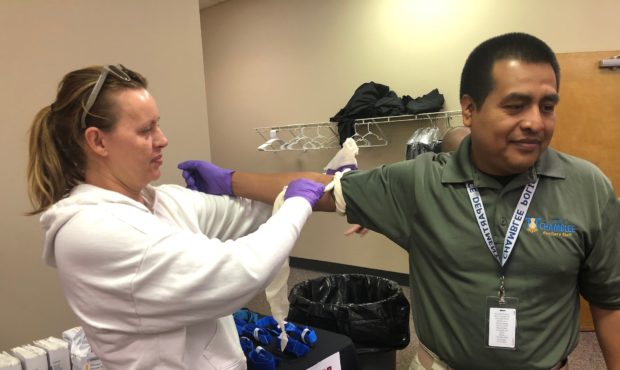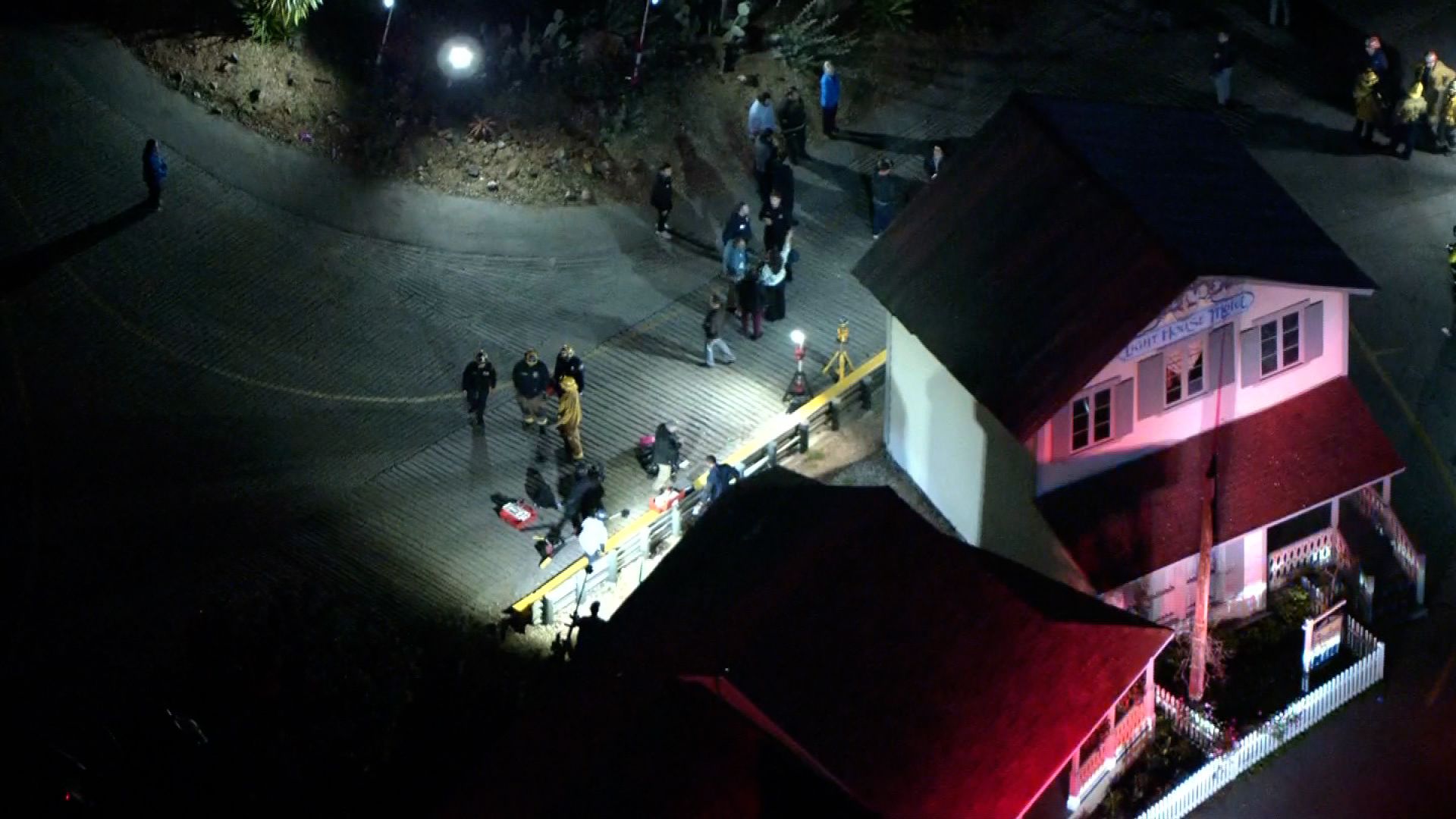This class teaches people to act as first responders in a mass shooting
May 12, 2019, 9:36 AM

Yvonne Bubienko stands over a flesh-colored dummy leg that appears to have suffered a deep and severe laceration. She takes an unrolled length of gauze and packs it deeper and deeper into the wound, filling the empty space beneath the surface of the skin. Photo: Dakin Andone/CNN
By Dakin Andone, CNN
(CNN) — Yvonne Bubienko stands over a flesh-colored dummy leg that appears to have suffered a deep and severe laceration. She takes an unrolled length of gauze and packs it deeper and deeper into the wound, filling the empty space beneath the surface of the skin.
Bubienko’s not squeamish, she says, but the fake bone on the inside of the leg is definitely a strange sensation.
“You really feel like you’re touching someone’s bone inside of their leg,” she laughs. “It’s just like, I’ve never really felt around inside someone’s leg.”
Bubienko and more than a dozen others have decided to spend their Saturday morning inside a municipal building in Chamblee, Georgia, to attend one of many classes being held across the country this month as part of the first annual National Stop the Bleed Month.
On the heels of two school shootings in North Carolina and Colorado — in which two young men died charging the gunmen, thereby saving more lives — the initiative aims to show the public there’s more than one way to be a hero.
The class teaches bystanders to act as first responders in an active shooter situation and other mass casualty events until police can take control of the scene and professionals can render aid. As the name suggests, Stop the Bleed focuses on preventing victims from bleeding to death — the No. 1 preventable cause of death after injury, according to the class instructor, Dr. Hudson Garrett.
‘It’s like knowing CPR’
Instead of sleeping in or going to brunch, these people huddled within the brown walls of the Chamblee Civic Center just north of Atlanta, the air conditioning blasting, as Garrett taught them how to put pressure on a wound, pack it full of gauze — and, if necessary, use a tourniquet to save someone’s limb or life.
Two tables on the side were piled high with packages of gauze and QuikClot and bright blue Velcro tourniquets. There were more dummies meant to simulate wounded extremities, purple medical gloves and bottles of hand sanitizer.
Attendees came from all walks of life — they were young and old, working and retired. There were several law enforcement officers in the room, and a few women who had medical experience as registered nurses or assistants in operating rooms.
Still others, like Bubienko, who works in the mortgage industry, were just civilians who wanted to learn how to be a better citizen and a better neighbor.
“How awful would it be for somebody to die in front of you?” she says after she’s filled the simulated wound with nearly an entire roll of sterile gauze. “It’s like knowing CPR. You never want to have to use it, but you would feel pretty bad if it was like, ‘Oh, wow. I could have done something.'”
Here’s what Stop the Bleed attendees learned:
Apply pressure
Everyone’s first priority, Garrett says, should be their own safety. He reminds them of oxygen masks on an airplane, and how all passengers are told to put on their own mask before helping others around them.
Bystanders should also alert 911 to the situation, Garrett tells the class. Callers should give as much information as possible, such as their location, an estimate of how many people are hurt and their specific injuries. They should also follow a 911 operator’s instructions.
Once that’s taken care of, bystanders can begin to address victims and identify the source of the bleeding.
“I’m going to ask a provocative question,” Garrett says. “How many of you are comfortable touching someone else’s blood that you don’t know without gloves?”
Almost no one reacts. “Notice that my hand’s not going up,” Garrett says, adding that — if possible — they should wear gloves to prevent the spread of blood-borne diseases.
The first step, Garrett says, is to apply direct pressure to the wound, he tells the class, which can take care of the large majority of bleeding issues.
Someone in this situation could use anything available, such as a piece of clothing or newspaper or simply the palm of their hand, to help put pressure on the wound and stop the bleeding, Garrett tells the class. But if it’s possible, Garrett says, they should use sterile gauze, which should be available in any first aid kit.
Pack the wounds
Stop the Bleed also teaches attendees to pack wounds, a “remarkably effective” method at controlling blood loss, Garrett says, whether the injury is from a gunshot or a laceration from a kitchen knife, for example.
“Law enforcement’s going to be much more in tune with the gunshot wound,” he tells the class, “but in today’s society, we want everybody to be prepared for either one.”
Again, it’s ideal to use sterile gauze to prevent the spread of infection. “But if you don’t have that, don’t worry about it,” he adds. “That’s somebody else’s problem at the hospital.”
According to Garrett, another helpful tool is hemostatic gauze, an advanced dressing that contains an agent to promote blood clotting and thus, stop the bleeding.
Following Garrett’s presentation, in the hands-on portion of the class, the class practices shoving gauze into a dummy’s leg that’s punctured with a simulated gunshot wound. Surprisingly, nearly everyone remains composed
Much like Bubienko, one volunteer feeds gauze into the hole, deeper and deeper, until the wound is filled and the gauze is sticking out of the leg.
Then he balls up the remainder of gauze — he grabs another handful for good measure — before pressing down and applying direct pressure to the wound.
Use a tourniquet
If the wound is to an arm or a leg, Garrett says, one of the most effective tools is a tourniquet, a device that wraps around an extremity and applies intense pressure to effectively slow blood flow.
“It’s OK to go directly to a tourniquet,” Garrett says, “because I know it’s going to be very, very effective.”
Many law enforcement officers, such as Officer Travis Darley of the Chamblee Police Department, carry tourniquets nowadays. On Christmas Eve, Darley says, he used one to save the life of a man who suffered a severe injury when fireworks went off in his hand.
Class attendees practice wrapping tourniquets around each other’s arms and tightening them.
Darley wrapped a velcro tourniquet around a volunteer’s leg and tightened it until he was uncomfortable. In a true life or death scenario, the officer tells him, he’d continue tightening. Bystanders will know the tourniquet is tight enough because the patient will be uncomfortable and may be in pain, Darley says.
But, Garrett says, it’s important to communicate that it could save their life, despite the pain. “If it hurts, it is working.”
He also emphasizes the importance of timestamping the tourniquet so that when the victim arrives at the hospital, trauma surgeons know how long it’s been on.
Some tourniquets conveniently come with a marker and designated tab to note the time, Garrett explains, for the benefit of medical professionals.
“If you use a tourniquet correctly,” he says, “it’s going to save a life. It will be effective.”
‘You did something to help’
The attendees of the Chamblee class aren’t the only civilians learning these skills. This month, as part of the nationwide initiative, hundreds of classes are scheduled in cities across the country to teach people these same skills.
Dr. Lenworth Jacobs, the chairman of the group that conceived the Stop the Bleed initiative in the wake of the Sandy Hook shooting, emphasized the simplicity of the class and what it teaches.
According to Jacobs, there are “significant spikes in interest” for the classes after mass shootings such as those in Las Vegas, Orlando and Parkland, Florida. Since the launch of the initiative, nearly 800,000 have been trained by Stop the Bleed, he said, and he hopes a million will have taken the class by year’s end.
Jacobs also pointed to the sense of empowerment it gives to those who take it.
A traumatic event such as a shooting or terrorist attack stays with survivors, he says. But if they’re trained and can do something to help, the skills can make them more “resilient” citizens.
“Nobody but you is going to realize you actually saved somebody’s life,” he said, “but that is a very, very powerful feeling, that you did something to help.”
Lt. Guy Antinozzi of the Chamblee Police Department said he recognizes that in some active shooter or mass casualty scenarios, the only option people are left with is to fight. But he said he hopes more emphasis is put on training and intuition.
“And if there’s nothing left besides fighting, then fight like it really matters because it’s the most important fight you’re ever going to be in,” he said. “But we have this training and this attitude that we’re not going to be victims. And that puts us all in a much better position.”
The-CNN-Wire
™ & © 2019 Cable News Network, Inc., a Time Warner Company. All rights reserved.













